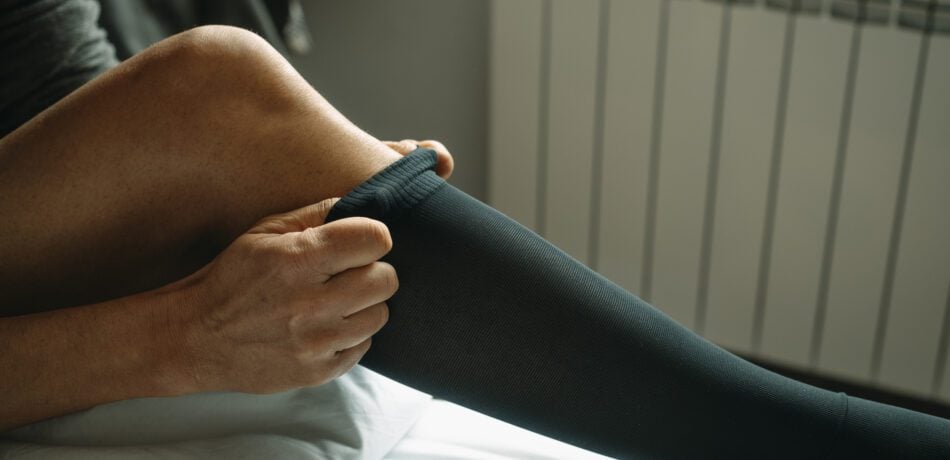Did you know there are specialized socks that can help you live a healthier life?
It’s true! Compression socks apply gentle pressure to your legs, which can help improve your circulation and support a host of health benefits.
What are the health benefits of compression socks, who should wear them, and what should you know before you buy? Keep reading for answers to all your questions!
What Are the Health Benefits of Compression Socks?
1. Boost Circulation
The pressure that compression socks apply to your legs can boost circulation not only locally, but throughout your whole body. Better circulation helps deliver blood and oxygen to your key organs and muscles. Plus, it helps reduce that uncomfortable “heavy leg” feeling.
2. Reduce Fluid Retention
When blood or lymphatic fluid build up in the legs, it can cause swelling, and it can develop into more serious conditions like blood clots and lymphedema. Compression socks help combat fluid retention and swelling by pushing blood upwards from the legs to the heart.
3. Relieve Heaviness and Achiness
For people who suffer from heavy or achy legs from exercise, extended periods of standing, or medical conditions, compression socks can alleviate these symptoms and help legs feel lighter and more energized.
Guaranteed Acceptance Life Insurance
Coverage options starting at $9.95 a month!
Guaranteed acceptance life insurance without medical exams, health questions, or rate increases.
4. Support Exercise
When worn during exercise, compression socks can help reduce stress on the muscles and may also help minimize repetitive impact. And when worn after exercise, compression socks can help improve recovery rates and reduce lactic acid buildup in tired muscles.
5. Improve Sleep Quality
When worn at night, compression socks are thought to help alleviate some conditions that can impact sleep quality, such as leg tingling and restless leg syndrome. They may also reduce the need to wake up to urinate at night.
6. Prevent or Manage Varicose Veins
Varicose veins are enlarged, twisted veins near the surface of the skin caused by weakened or damaged valves in the veins. Compression socks can help prevent varicose veins by working to minimize pooling blood in the legs, and they can help people who suffer from varicose veins manage their symptoms.
7. Help Manage Chronic Health Conditions
Compression socks may help manage symptoms of chronic health conditions such as POTS, neuropathy, orthostatic hypotension and more.
Get our 8 tips for coping with chronic illness and disability.
Who Should Wear Compression Socks?
There are many people of varying ages who could benefit from the advantages of wearing compression socks, including people who:
- Sit or stand all day
- Exercise
- Are taking a long flight or road trip
- Are pregnant
- Have certain medical conditions
- Are at risk of circulation problems like varicose veins, diabetes or DVT
- Are recovering from surgery
- Are bedridden
- Have, or are at risk for, lymphedema
Compression socks are generally safe and can be worn by anyone as long as they’re wearing the right size. However, they could be inappropriate for some people with certain medical conditions. Consult with your doctor to see if, how and when you should wear compression socks.
Afraid of routine health screenings and tests? Get our 7 tips to reduce anxiety.
What to Know When Buying Compression Socks
If you search for compression socks online or in stores, you may quickly become overwhelmed with options. You’ll notice that compression socks come in different pressures, lengths and colors. The two most common types of compression socks include:
- Graduated compression socks: This is the most common type, available in a variety of pressures. They tend to be tighter around the ankles and get looser as they go up the leg.
- Thrombo-embolic deterrent (TED) hose or anti-embolism stockings: These are prescribed by doctors for medical reasons and are designed to lower the risk of severe swelling.
Over-the-counter compression socks are typically labeled based on a range of compression in mmHg which is a unit of pressure. Options typically include:
- Low compression providing less than 20 mmHg. These are ideal for first-time wearers.
- Medium compression providing between 20 and 40 mmHg. These are great for people who need varicose vein control or are pregnant.
- Moderate to high compression providing between 30 and 40 mmHg. These are best for people who have severe pain or swelling.
- Firm compression giving between 40 to 50 mmHg. These should be used by people who have a history of severe vein problems or blood clots.
Talk to your doctor about how much compression you need and which style of compression sock is best for you.
Colonial Penn is here for you!
Colonial Penn has specialized in making life insurance simple and accessible by offering it directly to consumers since 1957. Click here to learn more.





